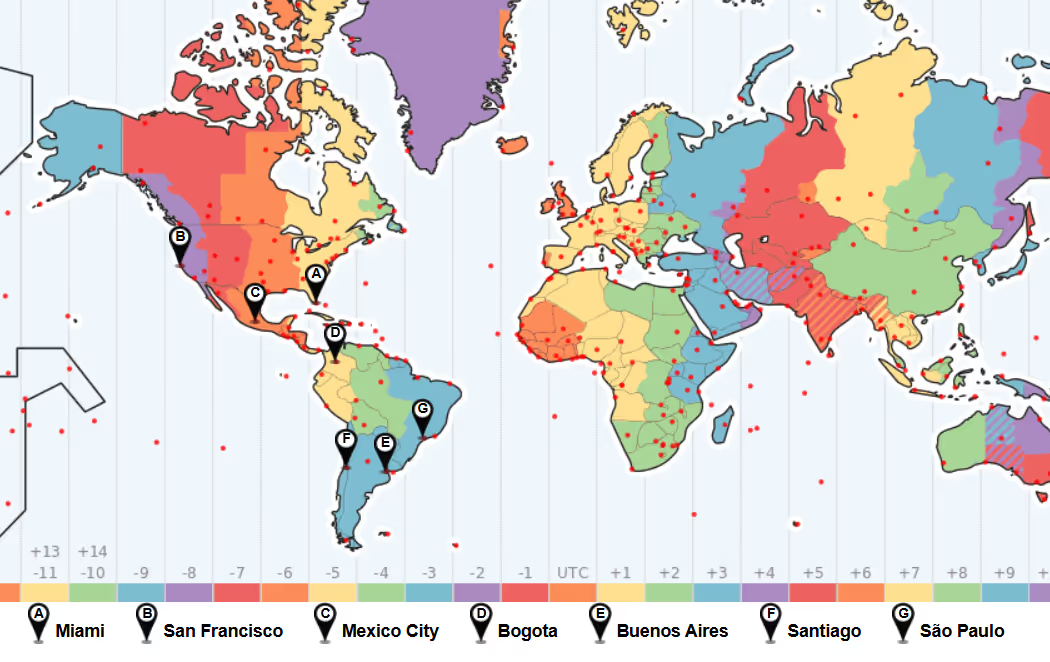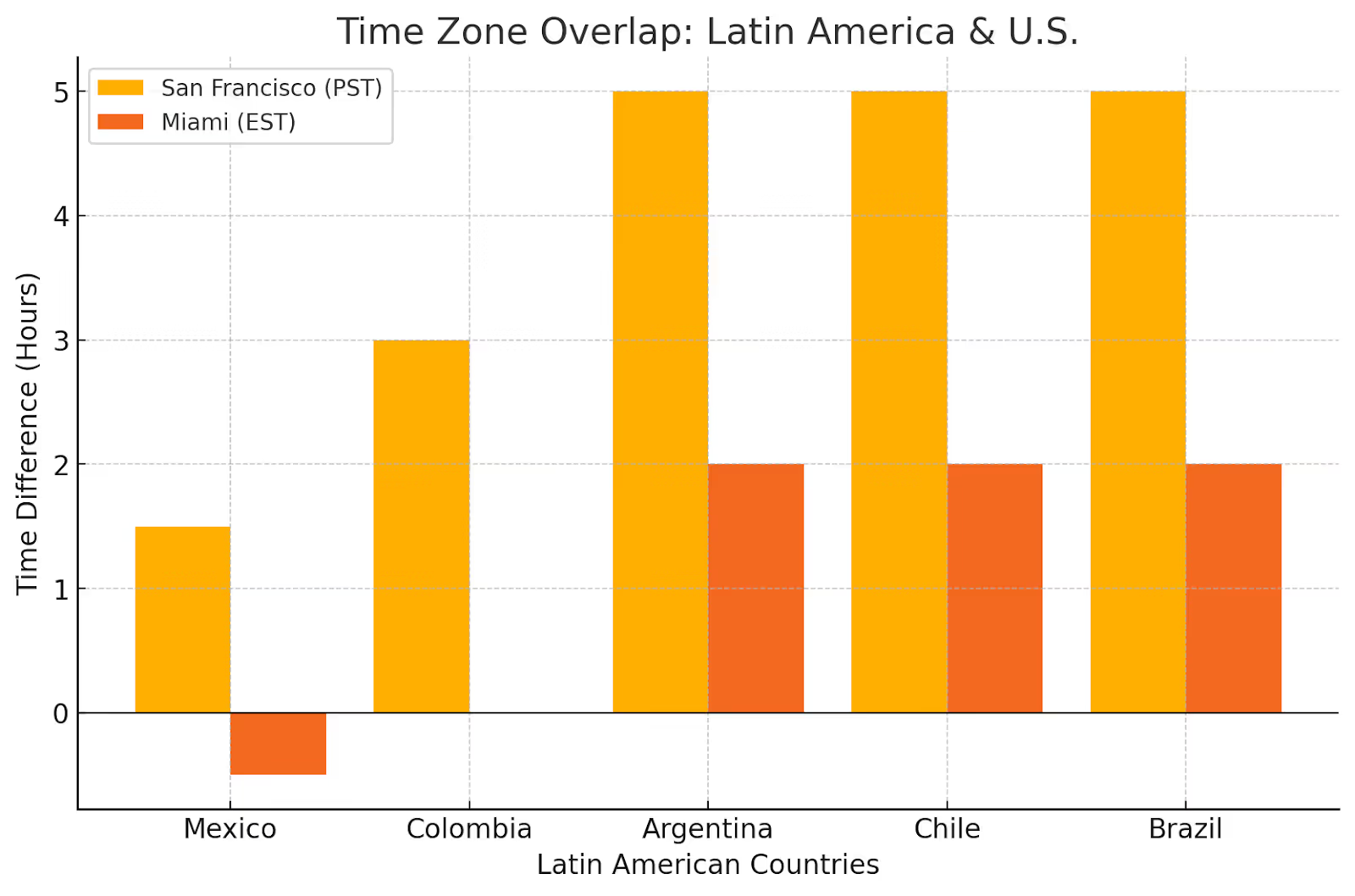Hiring remote talent can be a game changer for U.S. companies, but working in different time zones often results in communication delays and reduced efficiency. That's where time zone overlap comes into play. By hiring talent from Latin America, companies can collaborate in real time, streamline workflows, and increase productivity, all while taking advantage of a skilled and cost-effective workforce.
But which Latin American countries offer the best time alignment with the U.S., and how does time zone overlap affect remote teams in practice? In this blog, we'll explore the benefits of time zone overlap, the best countries for seamless collaboration, and how it can help your business.
Find out more about the top 5 benefits of DevOps outsourcing in Latin America.
The Advantages of Time Zone Overlap
Time zone overlap refers to the window of time when business hours in two different locations align, allowing teams to work simultaneously. This overlap can vary depending on the specific regions involved but generally provides a crucial advantage for teams that rely on real-time collaboration, quick decision-making, and efficient project management.

When U.S. companies hire remote talent from Latin America, they gain a strategic advantage by working with professionals from similar time zones. Here are five key benefits of overlapping time zones that make remote collaboration more efficient:
1. Real-time collaboration: One of the biggest challenges of working remotely is the communication gap that occurs when teams work in different time zones. Choudhury and his team analyzed the communications of more than 12,000 employees and found that voice and video calls decrease by 11% for every hour of time difference between workers.
2. Cost reduction: Outsourcing to nearby countries offers companies an excellent cost-benefit ratio. According to a global outsourcing survey conducted by Deloitte, 87% of technology companies are exploring the possibility of outsourcing services to nearby countries to reduce costs. Analysts predict that the global outsourcing market will grow to $40.16 billion by 2025.
3. Improved Project Management and Productivity: Having teams in the same time zone makes project oversight and coordination easier. Meetings and deadlines are managed without interruptions due to time zone differences. In addition, a study by the U.S. Patent Office found that the ability to work from any location increased productivity by 4.4%, reinforcing the positive impact of time synchronization.
4. Better work-life balance: According to a study published in the journal Organisation Science, employees resort to 'time-shifting' to adapt to flexible schedules or to meet urgent demands at work. These schedule changes can affect team communication patterns, as well as work-life balance, group collaboration and project management strategies.
Learn more about nearshore staffing.
Latin American Countries with Time Zone Overlap for the U.S.
Several Latin American countries closely follow the U.S. time zones, making remote collaboration seamless. Here's how their time zones compare to San Francisco (PST) and Miami (EST).

Mexico: Depending on the region, Mexico operates on Central Standard Time (CST, UTC -6) or Mountain Standard Time (MST, UTC -7). Remote workers in Mexico are only 1 to 2 hours ahead of San Francisco and on the same or only 1 hour behind Miami, making it one of the best options for U.S. companies.
Colombia: Colombia follows Colombia Time (COT, UTC -5), which puts it 3 hours ahead of San Francisco but perfectly aligned with Miami. It is ideal for companies operating on the East Coast and looking for real-time collaboration with no time difference.
Argentina: Argentina operates on Argentina Time (ART, UTC -3), which is 5 hours ahead of San Francisco and 2 hours ahead of Miami. While it has a greater time difference, it still offers several overlapping work hours, particularly for East Coast companies.
Chile: Chile follows Chile Standard Time (CLT, UTC -3), meaning it’s 5 hours ahead of San Francisco and 2 hours ahead of Miami. Despite the gap, the overlap allows for a significant portion of the workday to be shared with U.S. teams.
Brazil: Major business centers in Brazil follow Brasilia time (BRT, UTC -3), which puts them 5 hours ahead of San Francisco and 2 hours ahead of Miami. While this poses little challenge for West Coast companies, there is still significant overlap for real-time teaming.
For U.S. companies, the best matches depend on location: Miami-based businesses will find Colombia, Peru, Ecuador, and Mexico (CST) to be the most aligned, while San Francisco-based teams may benefit most from Mexico (MST) and Central America due to the smaller time difference.

Time zone aligned recruitment with Teilur Talent
At Teilur Talent, we understand the importance of time zone overlap for effective collaboration. We ensure that we align talent with your company's time zone, which facilitates communication, improves productivity and reduces time barriers. We also ensure that the talent shares your organization's values and culture for a smoother integration.
Our transparent pricing model ensures that you know exactly how much goes to the candidate and how much stays on our platform, with no surprises. We provide you with a clear breakdown of salary expectations and stock ranges before we contact a candidate, so you can make informed decisions from the start.
So not only do we streamline the hiring process to be efficient and fair, we also help you ensure that the talent is the perfect fit for your team, time zone and business vision.
Learn more about remote hiring: The Importance of Transparency for Developers and Clients.
FAQ
How does outsourcing across time zones work effectively?
Outsourcing across time zones requires aligning schedules to maximize overlapping working hours, using communication tools to stay connected, and being mindful of time differences to ensure seamless collaboration and timely project progress.
What time zone overlaps working hours is?
Time zone overlap working hours refer to the period during which the standard business hours of two different time zones coincide, allowing teams in these zones to work simultaneously and collaborate in real-time.
How do you calculate time overlap?
To calculate time overlap, identify the standard working hours in each time zone, then determine the common hours during which both teams are operational. For example, if Team A works from 9 AM to 5 PM EST and Team B works from 8 AM to 4 PM CST, there is a full overlap since EST is one hour ahead of CST.
What is timezone overlap?
Timezone overlap occurs when the working hours in different time zones intersect, allowing individuals or teams in these zones to be available simultaneously for communication and collaboration.
Conclusion
Hiring remote talent from Latin America offers U.S. companies a unique advantage—real-time collaboration, efficient communication, and cost-effective hiring—all thanks to time zone overlap. By working with professionals in regions that align with U.S. business hours, companies can streamline operations and boost productivity without the challenges of extreme time differences.
At Teilur Talent, we not only provide transparency in pricing but also ensure the time zone alignment that maximizes collaboration. We help you build high-performing remote teams with fair, competitive pricing while ensuring your talent is in sync with your business hours.
To help you make the best decision, use the calculator below to estimate your costs and potential savings. For more details and personalized advice, please contact us.








